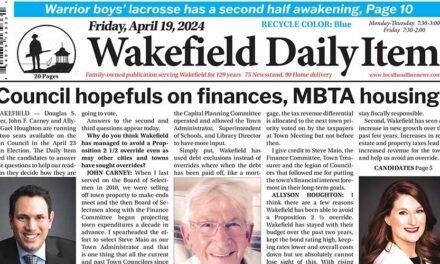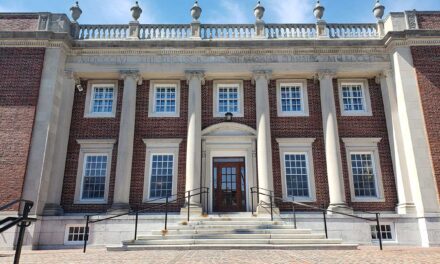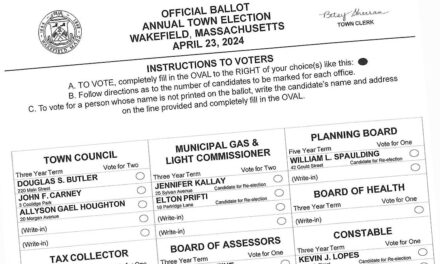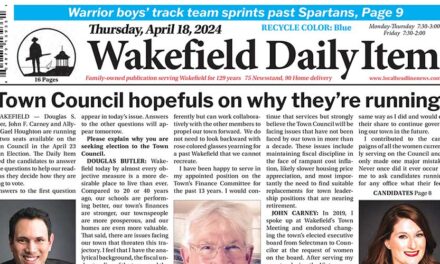Published in the December 2, 2015 edition
By MARK SARDELLA
WAKEFIELD – Downtown Wakefield needs some help but the picture isn’t as bleak as some have painted it.
That’s the conclusion of a consultant hired to help the town determine what steps are needed to increase the vibrancy and spur economic development in the downtown area. Peg Barringer of FinePoint Associates delivered her report last night to a group assembled at The Savings Bank that included representatives of the Wakefield Main Streets program and the Economic Development Committee along with town officials and department heads.
Barringer defined the downtown business district as the Main Street area, the Albion Street/North Avenue area and the Junction area. She said that the total downtown area contains over 920,000 square feet of commercial space. That, she said is more than MarketStreet in Lynnfield and only slightly less than the Burlington Mall.
As of October 2015, 7 percent of the square footage and about 12 percent of the commercial units were vacant. That, she said, meant that Wakefield was doing better than the national average when it comes to commercial vacancy rates.
Barringer described the area within a two-mile radius as the primary “trade area” for the downtown, from which it draws most of its customers. That trade area includes 40,548 residents and 16,655 households. Residents spend a total of $541 million per year, she said, of which over $199 million is spent outside of the primary trade area. She described the latter figure as “sales leakage.” That means that the downtown area is capturing 62 percent of the sales from the primary trade area, which she characterized as a “pretty strong capture rate.”
Barringer displayed a graph comparing local demand to local sales in various retail categories to show where the greatest sales leakage was as well as the best opportunities to capture those sales. Her report showed that the greatest areas of sales leakage were in categories like electronics, clothing, shoes and jewelry as well as beer, wine and liquor.
Barringer also talked about “non-resident markets” consisting of employees of area businesses who work in close proximity to the downtown business district. This market presents an opportunity for lunchtime meal purchases, as well as convenience items goods and services purchased before and after work.
In addition, Barringer’s report noted that Lake Quannapowitt and associated events draw large numbers of people into close proximity to the downtown. She recommended a number of ways to capture a large segment of this potential market. Developing a Wakefield software application for cell phones that markets local businesses, attractions and events would be one way to draw Lake-users to the downtown she said. Kiosks and signage marketing the downtown would also help, as well as promoting the availability of restrooms.
Barringer reviewed the “key take-aways” from her study along with some recommendations for boosting the economic vitality of the downtown area.
She noted that Wakefield has “a charming town center with many attractive historic buildings, a walkable layout and a lovely common.” This, she said, was exactly the type of atmosphere that lifestyle centers like MarketStreet in Lynnfield were seeking to recreate.
“Don’t think about downtown as just a shopping place,” she stressed. “Think of it as a social place.” Creating a streetscape that invites people to stay, stroll, sit and hang out will encourage people to stay and spend money, she said.
She also recommended forging stronger links between activity centers like the Common and the Americal Civic Center and downtown businesses. She noted that there are already many successful events in town that do just that. She suggested that other cultural organizations should be encouraged to host events in the downtown.
Barringer talked about prioritizing “target nodes” of areas with high walk-in trade located on the first floor and encouraging businesses with lower walk-in trade to locate on upper floors and other areas.
She also recommended encouraging “multi-channel selling.” Wakefield is a good location for businesses to have a retail selling floor and to also supplement revenue through Internet sales and/or wholesaling, she said.
Barringer recommended creating a business recruitment brochure/fact sheet that could be distributed to property owners and commercial real estate brokers and used by Wakefield Main Streets in their business recruitment efforts.
To be vibrant, Barringer said, the downtown has to have businesses that are open and look attractive and inviting. She said that local businesses need to give customers a reason to shop bricks and mortar versus the Internet.
She recommended encouraging residential development in the downtown to increase the customer base for businesses and add more 24-hour vitality. The new Galvin Middle School may make living near the downtown more attractive, she said.
The group discussed ways to encourage businesses to stay open later, as studies have shown that 70 percent of retail spending happens after 6 p.m. Ideas suggested included finding some kind of entertainment to keep people in the downtown after they go out to dinner or shop.
Barringer suggested issuing a “call for producers,” similar to an RFP, seeking people or groups willing to conduct events in the downtown. Designated areas like pocket parks for musicians to perform could also bring some activity to the downtown she said.
“The goal,” Barringer said, “is to reinforce the the downtown as the social center of the community, make people more aware of what is available in the downtown and increase the volume of downtown users, getting them to come more often and stay longer.”




